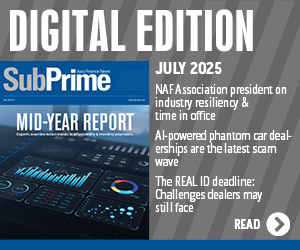KBRA reports cyclical non-prime auto ABS performance in July

If your non-prime portfolio performance is experiencing some cyclical turbulence this summer, it appears you might not be alone.
This week, Kroll Bond Rating Agency (KBRA) released its auto loan indices for July, reporting on delinquency roll rates from asset-level disclosures. Analysts said servicer reports showed mixed results across securitized prime and non-prime auto loan pools in July.
KBRA indicated that annualized net losses and 60-day delinquencies in KBRA’s prime auto loan index rose 10 basis points and 3 basis points month-over-month to 0.56% and 0.42%, respectively.
However, on a year-over-year basis, analysts discovered net losses and delinquency rates improved, falling 8 basis points and 1 basis point versus July of last year. This past month marked the 18th consecutive reporting period in which net losses and delinquency rates have fallen year-over-year within the index.
“Favorable year-over-year performance can be attributed to both index mix shift and tighter underwriting from a number of the prime issuers included in our index,” analysts said in the latest report.
Meanwhile, collateral performance in KBRA’s non-prime auto loan index underperformed last month.
Analysts found that annualized net losses rose 67 basis points month-over-month and 25 basis points year-over-year to 7.30%. Furthermore, the percentage of borrowers that were 60 days or more past due increased to 4.41%, up 59 basis points versus the previous month and 67 basis points compared to last July.
“The month-over-month deterioration in index performance was likely driven by seasonal factors as the benefit of tax refunds has already dissipated and borrowers are spending on summer travel,” KBRA said.
And it also might be looking like some contract holders are taking a vacation rather than getting caught up on their payments in their behind on their monthly commitments.
KBRA shared that an analysis of July’s loan-level data showed deteriorating credit conditions as the percentage of prime and non-prime borrowers who went from 60-plus days delinquent to current came in at 21.7% and 14.2%, respectively, down from 21.8% and 16.2% during the previous month.
Meanwhile, analysts pointed out the percentage of borrowers who were 60+ days delinquent to start July— and were subsequently charged-off by the end of the month — registered at 14.0% for prime loans and 23.4% for non-prime loans. These metrics are down slightly from the 14.3% and 24.1%, respectively, of seriously delinquent contracts that were charged-off in the previous month.
“Notably, although non-prime charge-offs have remained fairly steady over the past year, the decline in the 60-plus day cure rate is somewhat concerning as it could lead to increased losses in the coming months,” analysts said.
“This trend appears to be consistent across all three of the issuers that report loan-level data — (AmeriCredit, DriveTime and Santander Consumer USA) — and is certainly worth continued monitoring,” analysts went on to say.


